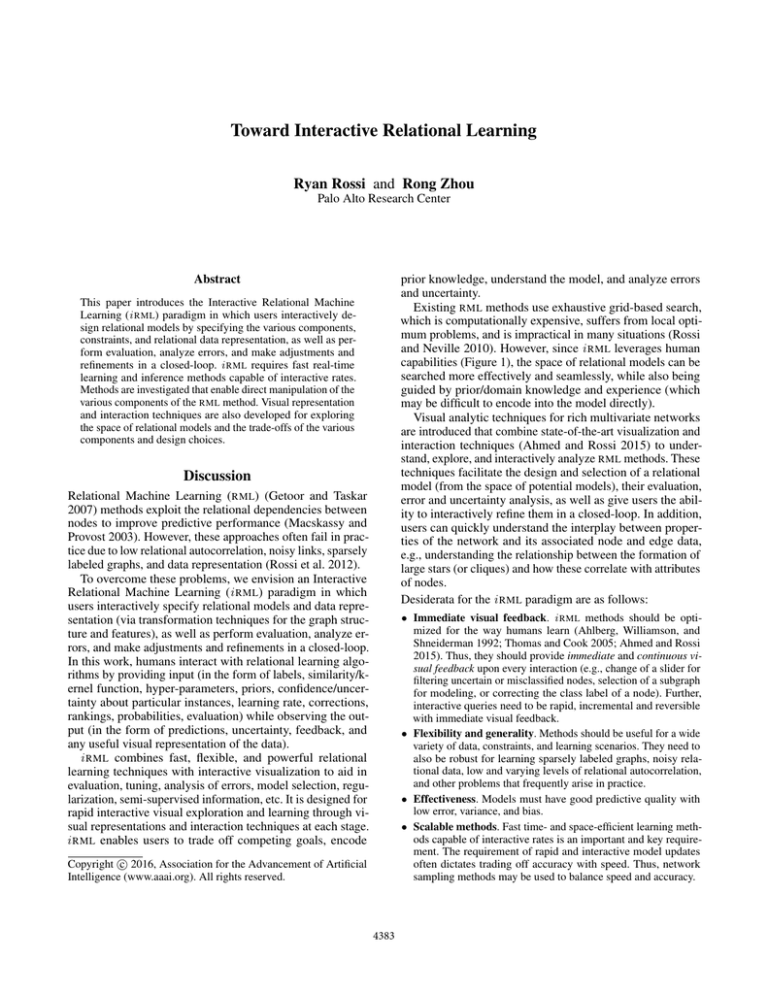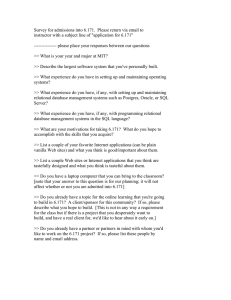
Toward Interactive Relational Learning
Ryan Rossi and Rong Zhou
Palo Alto Research Center
prior knowledge, understand the model, and analyze errors
and uncertainty.
Existing RML methods use exhaustive grid-based search,
which is computationally expensive, suffers from local optimum problems, and is impractical in many situations (Rossi
and Neville 2010). However, since i RML leverages human
capabilities (Figure 1), the space of relational models can be
searched more effectively and seamlessly, while also being
guided by prior/domain knowledge and experience (which
may be difficult to encode into the model directly).
Visual analytic techniques for rich multivariate networks
are introduced that combine state-of-the-art visualization and
interaction techniques (Ahmed and Rossi 2015) to understand, explore, and interactively analyze RML methods. These
techniques facilitate the design and selection of a relational
model (from the space of potential models), their evaluation,
error and uncertainty analysis, as well as give users the ability to interactively refine them in a closed-loop. In addition,
users can quickly understand the interplay between properties of the network and its associated node and edge data,
e.g., understanding the relationship between the formation of
large stars (or cliques) and how these correlate with attributes
of nodes.
Desiderata for the i RML paradigm are as follows:
Abstract
This paper introduces the Interactive Relational Machine
Learning (i RML) paradigm in which users interactively design relational models by specifying the various components,
constraints, and relational data representation, as well as perform evaluation, analyze errors, and make adjustments and
refinements in a closed-loop. i RML requires fast real-time
learning and inference methods capable of interactive rates.
Methods are investigated that enable direct manipulation of the
various components of the RML method. Visual representation
and interaction techniques are also developed for exploring
the space of relational models and the trade-offs of the various
components and design choices.
Discussion
Relational Machine Learning (RML) (Getoor and Taskar
2007) methods exploit the relational dependencies between
nodes to improve predictive performance (Macskassy and
Provost 2003). However, these approaches often fail in practice due to low relational autocorrelation, noisy links, sparsely
labeled graphs, and data representation (Rossi et al. 2012).
To overcome these problems, we envision an Interactive
Relational Machine Learning (i RML) paradigm in which
users interactively specify relational models and data representation (via transformation techniques for the graph structure and features), as well as perform evaluation, analyze errors, and make adjustments and refinements in a closed-loop.
In this work, humans interact with relational learning algorithms by providing input (in the form of labels, similarity/kernel function, hyper-parameters, priors, confidence/uncertainty about particular instances, learning rate, corrections,
rankings, probabilities, evaluation) while observing the output (in the form of predictions, uncertainty, feedback, and
any useful visual representation of the data).
i RML combines fast, flexible, and powerful relational
learning techniques with interactive visualization to aid in
evaluation, tuning, analysis of errors, model selection, regularization, semi-supervised information, etc. It is designed for
rapid interactive visual exploration and learning through visual representations and interaction techniques at each stage.
i RML enables users to trade off competing goals, encode
• Immediate visual feedback. i RML methods should be optimized for the way humans learn (Ahlberg, Williamson, and
Shneiderman 1992; Thomas and Cook 2005; Ahmed and Rossi
2015). Thus, they should provide immediate and continuous visual feedback upon every interaction (e.g., change of a slider for
filtering uncertain or misclassified nodes, selection of a subgraph
for modeling, or correcting the class label of a node). Further,
interactive queries need to be rapid, incremental and reversible
with immediate visual feedback.
• Flexibility and generality. Methods should be useful for a wide
variety of data, constraints, and learning scenarios. They need to
also be robust for learning sparsely labeled graphs, noisy relational data, low and varying levels of relational autocorrelation,
and other problems that frequently arise in practice.
• Effectiveness. Models must have good predictive quality with
low error, variance, and bias.
• Scalable methods. Fast time- and space-efficient learning methods capable of interactive rates is an important and key requirement. The requirement of rapid and interactive model updates
often dictates trading off accuracy with speed. Thus, network
sampling methods may be used to balance speed and accuracy.
c 2016, Association for the Advancement of Artificial
Copyright Intelligence (www.aaai.org). All rights reserved.
4383
Figure 1: Interactive Relational Machine Learning (i RML) Paradigm. Visual encoding of the results from the various components
are indicated via the top arrows, whereas user interactions are represented by the arrows at the bottom.
those nodes of interest. Our i RML system also supports interactive visual graph filtering (e.g., remove all uncertain nodes
above a user-specified threshold.). In addition, all visualizations are interactive and support brushing, linking, zooming,
panning, tooltips, etc. Efficient update rules are also derived
to avoid relearning the model (after each user interaction/visual query). For example, after the deletion (or insertion) of
a node, we can update the global relational model via a fast
localized update. These local updates enable real-time exploration capabilities by leveraging fast exact or approximate
solutions.
Many of the components in our i RML system may be
explored using interactive visualization and analytic techniques, including the attribute to predict, initial features to
use (non-relational and graph-based features), local model for
estimation, kernel function (RBF, linear, polynomial, etc.),
hyper-parameters (for selected kernel), node- and featurewise normalization scheme (L1, min-max, etc.), as well as
whether to use semi-supervised learning (SSL), and metafeatures (based on current estimates). Interactive link prediction methods and many other important learning components
are also included in our i RML system.
• Accessibility and simplicity. To be accessible to domain but
non-ML experts, i RML methods must be carefully designed to be
simple, intuitive, and easy-to-use. Whenever possible, assistance
and guidance from the system is desired.
• Principled models. Another challenge is the design of intuitive
learning and inference methods to facilitate interactive reasoning,
understanding, and derivation of theoretical behavior and guarantees. This enables quick understanding and refinement by the
user, while also providing a means to backtrack if warranted to
understand a specific outcome or anomaly.
• Unified & expressive models. A unifying family of relational
learning methods that express a large and multi-faceted space of
relational models. These models must perform well across a variety of different data, characteristics, and assumptions. They must
also generalize to a variety of learning settings (e.g., relational
active learning, online/incremental learning, ...).
References
Ahlberg, C.; Williamson, C.; and Shneiderman, B. 1992. Dynamic queries for information exploration: An implementation
and evaluation. In Proc. of SIGCHI, 619–626.
Ahmed, N. K., and Rossi, R. A. 2015. Interactive visual graph
analytics on the web. In ICWSM, 566–569.
Getoor, L., and Taskar, B., eds. 2007. Introduction to Statistical
Relational Learning. MIT Press.
Macskassy, S., and Provost, F. 2003. A simple relational classifier. In SIGKDD MRDM, 64–76.
Rossi, R., and Neville, J. 2010. Modeling the evolution of discussion topics and communication to improve relational classification. In SIGKDD SOMA, 89–97.
Rossi, R. A.; McDowell, L. K.; Aha, D. W.; and Neville, J. 2012.
Transforming graph data for statistical relational learning. JAIR
45:363–441.
Thomas, J. J., and Cook, K. A. 2005. Illuminating the Path: the
research and development agenda for visual analytics. IEEE.
Figure 2: i RML overview. This screenshot is from cora – a
common RML benchmark data set (Macskassy et al.).
An overview of our i RML system is shown in Figure 2.
In that example, we first interactively learn a model, then
select the misclassified nodes for further analysis. The global
statistics of the selected subgraph are shown in the right-most
panel. Node color represents the model’s uncertainty using
an entropy-based measure, whereas the size of the node indicates whether it was correctly classified or not. In Figure 2,
misclassified nodes are given a larger size so that they can
easily be identified for further exploration. Uncertainty (and
learned class prob. distribution, statistics, etc.) of a node or set
of nodes may also be displayed by selecting or mousing over
4384




